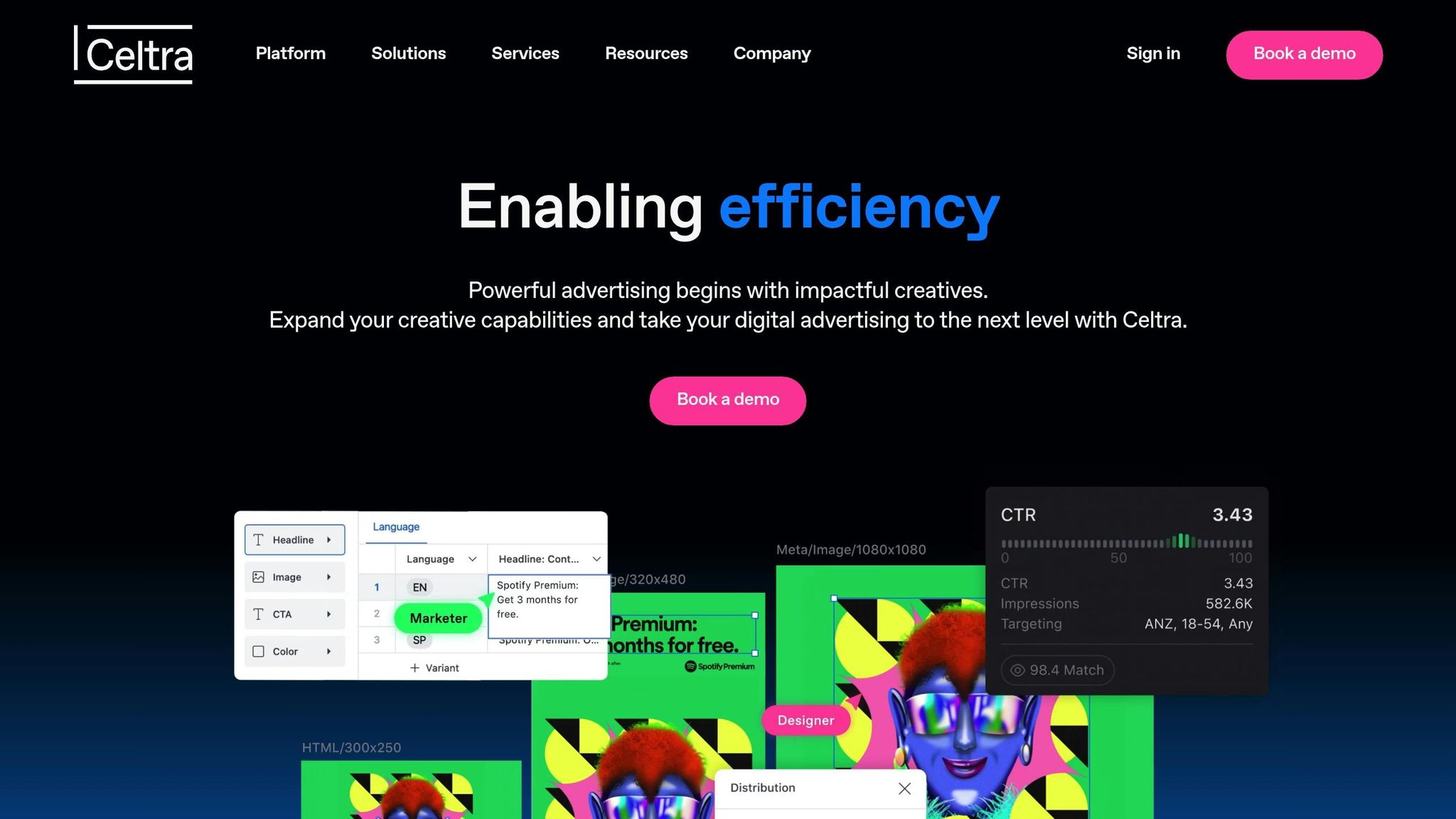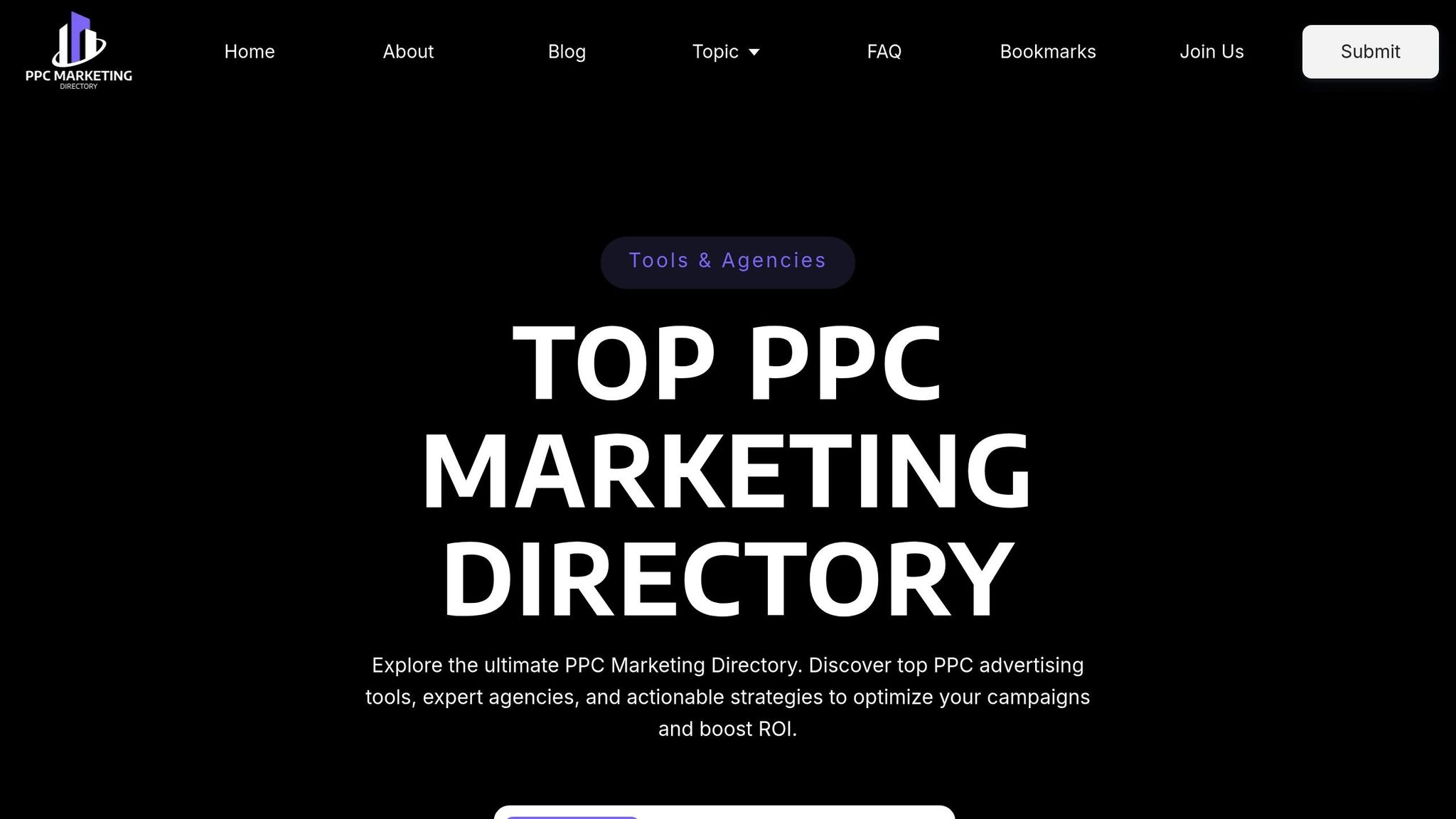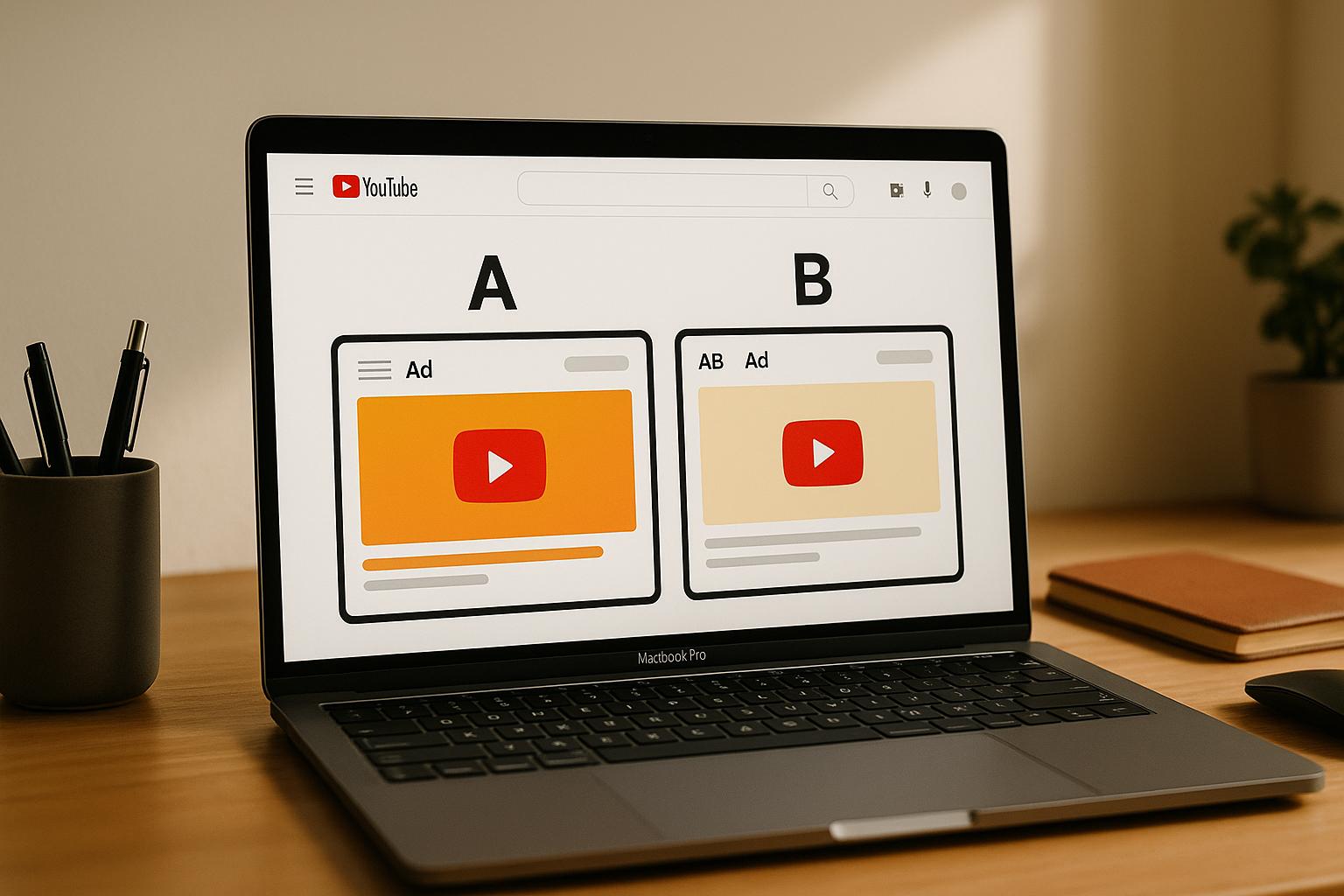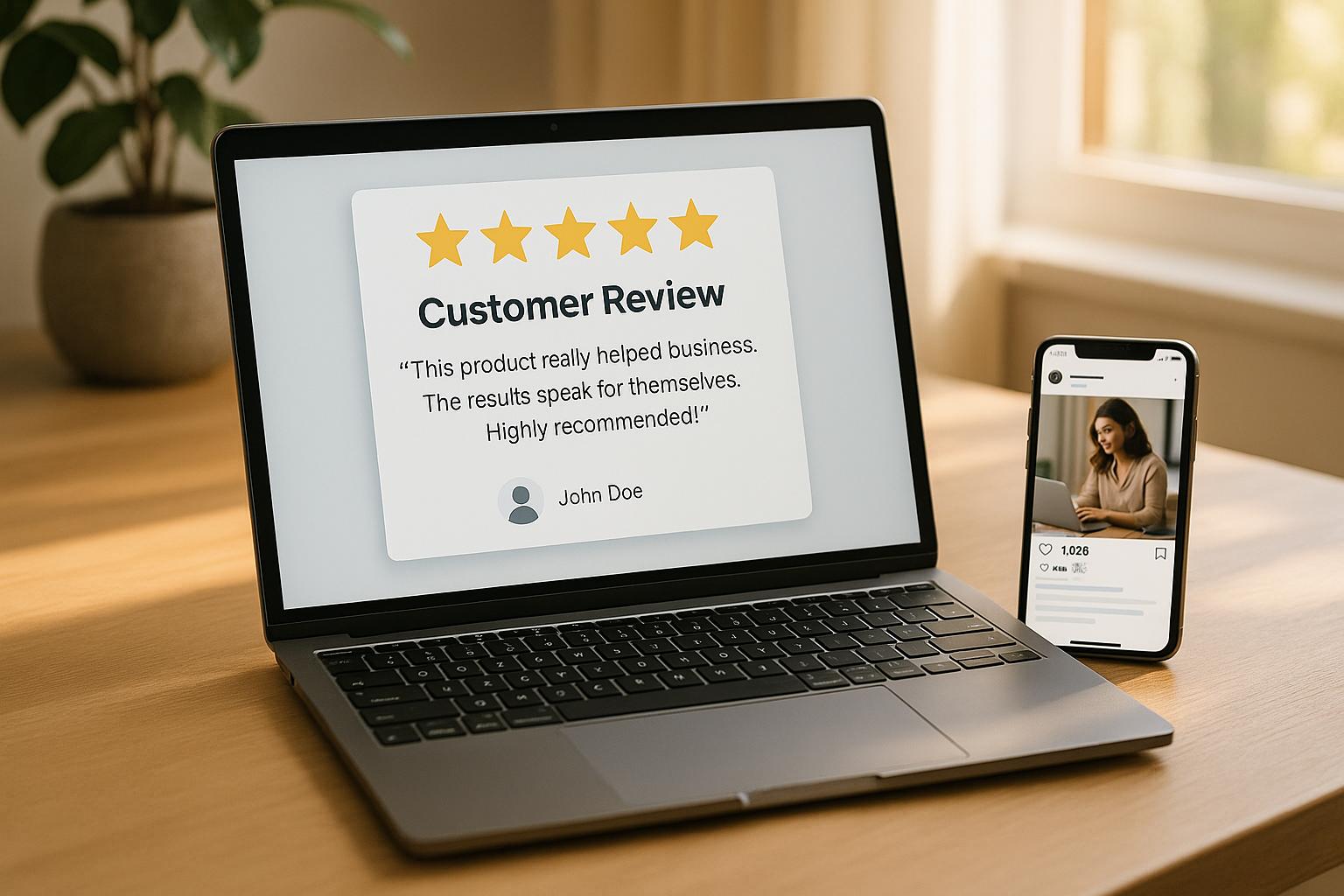Ad creative automation simplifies the process of managing PPC campaigns by automating repetitive tasks such as generating variations, personalizing ads, and optimizing performance. This approach saves time, maintains brand consistency, and improves campaign outcomes. However, it comes with challenges like ensuring brand alignment across platforms, scaling personalization, and meeting platform-specific requirements.
Key Takeaways:
- Why It Matters: Modern PPC campaigns require precision and scale. Automation reduces manual work, combats ad fatigue, and allows teams to focus on strategy.
- Main Goals: Automation aims to improve efficiency, ensure brand consistency, and optimize performance through real-time adjustments.
- Challenges: Maintaining brand identity, handling platform-specific requirements, and managing creative fatigue are common obstacles.
- Solutions:
- Modular design systems for consistent branding.
- AI for real-time personalization and optimization.
- Centralized asset management for streamlined workflows.
- Performance feedback loops to refine campaigns based on data.
By combining the right tools and strategies, marketers can scale campaigns efficiently while maintaining quality and relevance. Tools like Celtra, Shakr, AdCreative.ai, and Bannerbear offer automation solutions tailored to various needs, from video ads to multi-platform distribution.
Celtra x Ad Age: Best-kept creative automation secrets from the world's top brands

Common Problems in Ad Creative Automation
Ad creative automation offers a path to greater efficiency, but it doesn’t come without its challenges. From ensuring a consistent brand identity across various platforms to navigating the technical demands of different advertising ecosystems, these hurdles can complicate the process. Recognizing these common issues is the first step in creating smoother, more effective automated workflows. Let’s dive into some of the most pressing challenges.
Keeping Brand Consistency Across Platforms
One of the toughest parts of automating ad creatives is maintaining a cohesive brand voice and visual identity across multiple platforms. Each platform has its own unique audience, creative formats, and expectations. This can lead to ads that technically meet platform requirements but fail to reflect the brand’s personality.
The problem becomes even trickier when automation generates a large number of creative variations. Without proper safeguards, these tools might churn out ads that stray from the brand’s core identity. For marketers, this often translates to challenges in ensuring templates are standardized. A design that works flawlessly on one platform might not adapt well to another, creating a fragmented experience that confuses audiences and diminishes campaign impact.
Scaling Personalization Without Overloading Teams
Personalization is a must in today’s marketing world, but doing it at scale can overwhelm even the best teams. Tailoring ads for different audience segments, locations, and behaviors requires a staggering number of creative variations. Add in seasonal campaigns and A/B testing, and you’re looking at dozens - if not hundreds - of ad assets.
For smaller teams, reviewing every automated output while juggling strategic priorities can feel impossible. This often results in rushed approvals or delays in campaign launches. Worse, time spent on managing creative production and reviews leaves little room for performance analysis and optimization. In these cases, automation can outpace a team’s capacity, turning a tool meant to save time into a source of stress.
Meeting Platform-Specific Requirements
Every advertising platform is its own universe, complete with unique technical specs, content rules, and algorithms. What works on one platform might flop on another, forcing marketers to constantly tweak creative approaches.
For example, Instagram Stories require a 9:16 aspect ratio, while LinkedIn prefers a 1.91:1 format. Add in character limits, file size restrictions, and supported formats, and the process becomes even more complicated. Automation can help, but if it doesn’t account for these nuances, ads might get rejected or perform poorly.
Content policies are another headache. Platforms have different rules about claims, imagery, and targeting. An ad that’s fine for one platform could trigger account restrictions on another. Automated systems need to stay on top of these differences to produce ads that are both compliant and effective.
Fast Testing and Data-Based Optimization
In the fast-paced world of digital advertising, quick testing and optimization are non-negotiable. Algorithms on major platforms are updated frequently, making it critical for marketers to constantly test and refine their campaigns.
Automation can generate multiple creative variations at once, but analyzing the data to identify what works can become a bottleneck. Teams often have to make decisions before enough data has been gathered, which can lead to missed opportunities.
Another issue is creative fatigue. Ads that perform well initially may lose their effectiveness over time, requiring constant monitoring to keep engagement high. Without strong tracking systems, teams might not notice a drop in performance until it’s too late.
Testing across multiple platforms adds yet another layer of complexity. A creative that resonates on one platform might fall flat on another due to differences in audience behavior and context. Unfortunately, many automation tools lack the advanced coordination needed to track and optimize cross-platform performance effectively.
Solutions for Better Ad Creative Automation
Ad creative automation doesn't have to be overwhelming. With the right strategies and tools, marketers can create systems that balance brand consistency, scale personalization, and meet the demands of different platforms. The key lies in building workflows that enhance automation rather than complicate it. Here's how you can tackle the challenges head-on.
Modular Design Systems: Building Blocks for Consistency
Modular design systems are a game-changer for maintaining brand consistency. Instead of starting from scratch for every ad, these systems rely on reusable components like headers, buttons, copy, and brand graphics. Think of it as a toolkit where elements can be mixed and matched while staying true to your brand's identity.
The foundation of this approach is design tokens - variables that define your brand's colors, fonts, and spacing. By referencing these tokens, every ad automatically aligns with your brand guidelines. This method allows for countless creative variations while ensuring each one feels unmistakably yours.
Modular systems also simplify adapting content for different platforms. Whether it's an Instagram Story, a LinkedIn post, or a Google Display ad, your messaging and visuals remain consistent. To top it off, approval workflows can be integrated to flag ads that need a human review - like those with new messaging or sensitive topics. This adds a layer of quality control without slowing down the automation process.
Real-Time Personalization with AI
Scaling personalization is no small feat, but AI makes it possible by tailoring creative elements to individual audience data. These systems analyze user behavior, demographics, and engagement patterns to deliver the most relevant content to each viewer.
AI doesn't just stop at selecting creative elements - it optimizes them in real time. For example, a fitness app could highlight outdoor workouts on sunny days and indoor options during bad weather, all without manual input. It also keeps campaigns fresh by rotating creative elements or pausing underperforming ads before audiences lose interest.
This dynamic approach isn't just reactive; it's predictive. By analyzing trends and engagement data, AI can proactively refine targeting and suggest adjustments, ensuring your campaigns stay effective and relevant.
Centralized Asset Management: Your Creative Hub
A centralized asset management system is your go-to solution for organizing and distributing creative assets. Acting as a single source of truth, it ensures that teams always have access to the latest logos, images, and templates.
With centralized systems, version control happens automatically. When brand guidelines change or new assets are approved, updates are instantly applied across all campaigns. This eliminates the risk of outdated visuals or messaging slipping through the cracks.
Role-based access further streamlines workflows. Designers can upload approved assets, marketing managers can create campaigns, and automation tools can pull what they need - all without manual file transfers. Plus, with integration capabilities, these platforms can connect directly to advertising tools, making it easy to update ad templates with new assets in just minutes.
Performance Feedback Loops: Continuous Improvement
Automation isn't a "set it and forget it" process - it thrives on feedback. Effective feedback loops turn performance data into actionable insights, helping your campaigns improve over time.
With real-time performance monitoring, you can catch problems early, like a drop in click-through rates or a spike in conversion costs. Automated alerts notify your team, allowing for quick adjustments that save time and money.
Cross-platform data integration provides a holistic view of your creative's performance. For instance, an ad that struggles on Facebook might excel on LinkedIn, and this insight can guide future decisions. The best systems also include optimization triggers - when performance dips, the system can pause the ad, boost budgets for top performers, or generate new variations to test.
Looking ahead, performance prediction is becoming a powerful tool. By analyzing historical data and trends, these systems can forecast which creative strategies are likely to succeed, helping you allocate resources wisely and avoid costly missteps.
sbb-itb-89b8f36
Top Tools and Platforms for Ad Creative Automation
Choosing the right automation platform can turn a sluggish workflow into a smooth, efficient process. The best tools offer AI-driven personalization and multi-platform distribution, all while aligning with your specific needs and budget.
Popular Tools for Automation
Here’s a closer look at some standout tools that are reshaping ad creative automation:
Celtra specializes in producing display, video, and interactive ads. It can generate thousands of variations from a single template while maintaining brand consistency. With dynamic creative optimization, Celtra fine-tunes elements like headlines, images, and calls-to-action automatically.
Shakr focuses on video ad automation. Using AI, it creates multiple variations by swapping text overlays, visuals, and background music. Its extensive template library is tailored for platforms like Facebook, Instagram, TikTok, and YouTube, ensuring your videos meet each platform's technical specs without extra effort.
AdCreative.ai leverages machine learning trained on millions of successful ads to craft optimized creatives. The platform analyzes your brand assets and generates ads with tailored layouts, color schemes, and copy variations. It even predicts performance before your ads go live, helping you focus on the most promising options.
Bannerbear is an API-first solution ideal for integrating creative automation into your existing workflows. It excels at producing personalized images, videos, and banners at scale by pulling data from spreadsheets, databases, or third-party apps to automatically customize creative elements.
How Top PPC Marketing Directory Helps

The Top PPC Marketing Directory is a curated resource for businesses and marketers looking to refine their paid advertising strategies. It connects users with top PPC tools, agencies, and services, offering insights into campaign management, bid strategies, keyword research, ad copy optimization, A/B testing, retargeting, and performance tracking. This platform makes it easier to compare solutions and find the best fit for your marketing needs.
Tool Comparison Chart
| Platform | Best For | Starting Price | Key Strengths | Platform Support |
|---|---|---|---|---|
| Celtra | Display & interactive ads | $2,000/month | Dynamic optimization, brand consistency | All major ad networks |
| Shakr | Video automation | $99/month | Video templates, social optimization | Facebook, Instagram, TikTok, YouTube |
| AdCreative.ai | Performance prediction | $29/month | AI-powered generation, performance forecasting | Google Ads, Facebook, LinkedIn |
| Bannerbear | API-first integration | $19/month | Developer-friendly, custom workflows | Any platform via API |
The pricing for these tools varies widely based on your needs and scale. For smaller businesses or those just starting with automation, AdCreative.ai offers an affordable entry point at $29 per month. Shakr, at $99 monthly, is ideal for businesses focused on video campaigns, while Celtra is designed for enterprise-level users who need a comprehensive suite of features and dedicated support.
When choosing a platform, think about your team's technical skills and budget. Bannerbear requires developer resources to unlock its full potential, whereas AdCreative.ai is user-friendly enough for marketing teams without technical expertise. Tools like Celtra and Shakr strike a balance, offering intuitive interfaces with advanced features for those who need them.
Finally, consider integration capabilities. A platform that connects seamlessly with your existing ad accounts, analytics tools, and asset management systems can save time and reduce workflow disruptions as your automation strategy grows.
Best Practices for Scaling Automated Ad Content
Scaling automated ad content effectively requires a well-thought-out strategy to maintain high performance and consistency.
Building Reusable Templates
Reusable templates play a key role in scaling ad automation. By designing them in a modular way, you can keep core elements consistent while swapping out variable components like images, headlines, or calls-to-action (CTAs).
Start by identifying the fixed elements that will stay consistent across all campaigns - think brand colors, fonts, logo placement, and the overall messaging structure. These form the foundation of your templates. The variable elements, such as product images, pricing, and CTAs, should be designed to easily interchange without disrupting the overall design.
When creating templates, make sure they align with the technical specifications of each platform. For example, a Facebook video ad will have different requirements than a Google display ad. Use clear naming conventions to keep things organized, such as "ProductShowcase_1200x628_FB_VideoTemplate", so anyone on your team can quickly understand the template's purpose and platform.
Before rolling out templates at scale, test them with a variety of content types. A template that works well for one product line might not be suitable for another due to differences in visuals or messaging needs. Once templates are finalized, ensure every creative output adheres to strict brand guidelines.
Setting Clear Brand Guidelines
Clear brand guidelines are essential for maintaining consistency across automated ads.
For visual elements, provide precise specifications instead of vague instructions. For example, include exact hex codes or RGB values for brand colors, and clarify how they should be used (e.g., background versus text). Define acceptable logo sizes, variations, and spacing rules to ensure brand elements are always displayed correctly.
Equally important are voice and tone guidelines, especially when AI tools are involved in generating copy. A detailed style guide should outline approved phrases, words to avoid, and examples of on-brand versus off-brand messaging. Include specific instructions on punctuation, capitalization, and formatting to ensure your brand’s personality shines through consistently.
To maintain quality, integrate content approval workflows into your automation process. Decide which types of content can be published automatically and which require human review. For instance, routine promotions might not need much oversight, but high-stakes campaigns or ads for sensitive products should undergo additional checks.
Finally, account for platform-specific adjustments. Your brand voice might lean casual on social media but stay formal on email campaigns. Similarly, visual styles may need slight tweaks for different platforms while still reflecting your core brand identity. Document these variations to ensure consistency across channels.
With templates and guidelines in place, the next step is to use data analytics to keep your campaigns fresh and impactful.
Using Data Analytics to Prevent Ad Fatigue
To keep your scalable campaigns performing well, it’s crucial to monitor metrics and prevent ad fatigue. Overexposure can lead to diminishing engagement and higher costs, so set up automated alerts to flag when ads are shown to the same audience too frequently.
Data should guide your creative rotation. Regularly evaluate key metrics like click-through rates, conversion rates, and cost per acquisition. If performance starts to dip, it’s a clear signal to refresh your creative assets. A/B testing can help identify which elements resonate best with your audience, allowing you to refine your messaging and visuals.
Dashboards are invaluable for tracking performance across platforms. By having a centralized view, you can spot trends early and make adjustments before fatigue sets in. This proactive approach ensures your campaigns remain effective and engaging over time.
Conclusion: Improving Results with Automation
Ad creative automation is reshaping how PPC campaigns are executed, making it possible to scale creative production without sacrificing quality or consistency. Challenges like managing large-scale production and delivering personalized experiences are now more manageable, thanks to well-planned automation strategies.
The numbers back this up. Studies highlight that ad creative is the most critical factor influencing campaign success, often outweighing targeting and budget tweaks. Meta's research underscores this point, showing that creative elements drive ad performance more than any other factor, making automation an essential tool for staying competitive.
A well-rounded approach - using modular design, AI-driven personalization, centralized asset management, and performance feedback - enables marketers to create scalable, high-performing campaigns. Automation also fosters collaboration between creative and media teams, accelerating data-driven optimizations. What used to take weeks can now be achieved in just hours, allowing brands to adapt quickly to market shifts and seize new opportunities. These time and efficiency gains provide a clear competitive advantage.
For marketers seeking solutions, the Top PPC Marketing Directory is a valuable resource. It offers a curated list of tools, agencies, and services designed to simplify ad creative automation. Whether you need tools for refining ad copy or platforms for advanced retargeting, having access to trusted options makes it easier to find the right fit for your needs.
The brands that succeed in the future will be those that seamlessly combine creative automation, AI, and data-driven insights to deliver personalized, impactful campaigns at scale. By implementing the strategies discussed - such as building reusable templates, maintaining strong brand guidelines, and leveraging real-time analytics - marketers can tackle today's challenges while setting themselves up for long-term success in an increasingly automated advertising landscape.
The real question isn't whether to embrace ad creative automation, but how quickly you can put it into action. With the right tools and strategies, achieving better PPC performance through automation has never been more within reach.
FAQs
How can businesses maintain consistent branding when automating ad creatives across different platforms?
To keep branding consistent while automating ad creatives, businesses need to start with clear brand guidelines. These guidelines should cover essential elements like visual style, tone of voice, and messaging. Think of them as the blueprint that ensures every creative piece aligns with your brand, no matter the platform.
Using automation tools with customizable templates is a smart way to tweak designs for various platforms without losing your brand's identity. Centralizing all creative assets in one platform can also make a big difference - it helps maintain consistency, minimizes mistakes, and makes teamwork smoother. On top of that, AI-powered tools can take over repetitive tasks, saving time while sticking to your brand's standards.
How can marketers scale personalized ad campaigns effectively without overwhelming their teams?
To expand personalized ad campaigns without overwhelming your team, start by bringing all customer data into one unified system. This ensures that decisions are based on accurate, well-rounded insights. Instead of diving in too fast, focus on gradual scaling - test personalization strategies with smaller audience segments first. This approach allows for quick wins and helps build momentum as you fine-tune your efforts.
Make use of automation tools to handle repetitive tasks like creating ads, segmenting audiences, and tracking performance. These tools not only cut down on manual work but also make it easier to manage growth. At the same time, ensure that teams are working together seamlessly to maintain consistency across campaigns. Regularly update audience segments to keep your ads fresh and relevant. By blending automation with thoughtful planning, you can scale personalized campaigns effectively and sustainably.
What should businesses consider when selecting an ad creative automation tool that fits their needs and budget?
When picking an ad creative automation tool, it's important to think about how well it can grow with your needs. The tool should be able to manage increasing demands and support a variety of ad formats across different channels. Also, check if it integrates smoothly with the marketing platforms you already use - this can save time and simplify your workflow.
Ease of use is another key factor. The tool should be straightforward enough for your team to start using without a steep learning curve. Features like maintaining brand consistency and scaling personalization are crucial to ensure your campaigns feel unified and tailored to your audience. Lastly, take a close look at the pricing. Make sure it fits your budget while still offering the features that matter most to your business.


